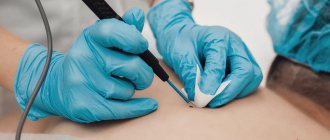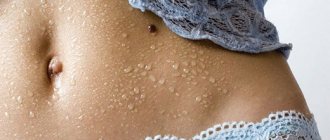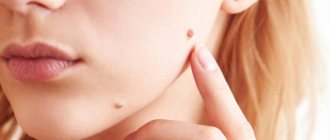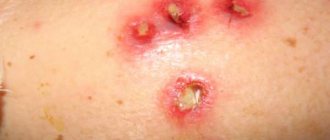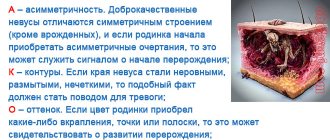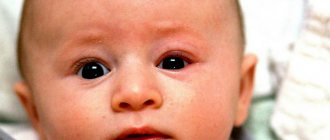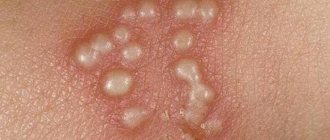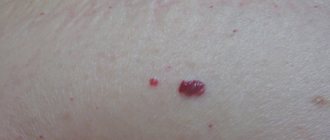Moles in newborns.
Many people are sure that moles are spots on our body that we were born with.
However, is this really true? In fact, quite a few children are born with moles on their bodies. Moles got their name for a different reason. First of all, moles, or nevi, are transmitted genetically through parents. Hence the name “moles”. Popular moles that a child had at birth are called birthmarks. Such spots actually appear with the birth of a child and grow with the growth of the newborn. The question of when moles appear in newborns may sound incorrect. The fact is that birthmarks on the body of a newborn can be noticeable, or they can be barely visible. At first they appear as a bright spot that is difficult to see with the naked eye. Over time, the spot becomes darker, and you realize that your child has a “birthmark”. By the way, many parents are proud of their birthmarks, which are passed on from generation to generation, so the appearance of a pedigree birthmark on a child is eagerly awaited.
Many people are interested in the question of why moles appear in children.
- Genetics. First of all, it’s all about a genetic predisposition to this, for example, dad or more likely mom has the same mole in the same place or nearby. There's nothing you can do about it. But it happens that children develop moles that do not decorate them in any way, but they should not be removed while the child is very small, because The nevus may appear again and you will have to have surgery again.
- Hormones. This is also a common cause of moles in children, but it is extremely rare that it occurs in infancy.
- UV rays. Newborns do not sunbathe or go to the beach with their parents, so this option is also excluded.
In addition, you can independently understand in advance with a high probability of coincidence that the child will have a birthmark at birth. The fact is that most often the following are born with nevi:
- Light-skinned children
- Girls (about 4-5 times more often than boys),
- Premature babies.
What is a birthmark?
When pigmented formations appear, the significance in a newborn depends on their shape, type and location. In most cases, infants have nevi and hemangiomas, which are formations on the skin that appear due to increased production of the coloring pigment melonin or the accumulation of blood vessels.
Nevi and hemangiomas have different shapes and sizes; most often they form in the baby during prenatal development. New growths on the skin can be flat, convex, smooth, dark or light. The photo can be seen below.
Melanocytes, special cells of the dermis containing the coloring pigment melanin, are responsible for the color saturation of nevi. The more melanin they contain, the darker the color of the tumor.
Main risk group:
- a girl is more likely to develop hemangioma than a boy;
- premature babies;
- babies with fair skin type.
Doctors believe that such babies have a higher risk of developing skin nevi and hemangiomas than other children.
Moles in children.
Most often, the first nevi appear in childhood. But when children have moles, only parents know who remember every centimeter of the child’s body. It is impossible to say specifically that moles in children appear strictly at 3 years or at 5 years - everything is individual and depends on several factors:
- Child maturation
- Staying in the sun
- Genetics.
A genetic predisposition cannot be ruled out, so if the parents’ first moles appeared late, then the child will probably not get moles early, and if the parents have a lot of moles, then the baby will have a lot of moles.
Attention! To protect your child from the appearance of new moles, try to protect him from sun exposure, especially from sunburn. In summer, the baby should wear clothing (not warm) that covers exposed skin, such as a Panama hat. Always apply sunscreen to your child's skin before leaving the house, and at the beach, make sure he plays in the shade, such as under a beach umbrella.
So at what age do moles appear? According to statistics, the first moles appear in children at the age of 1-2 years. By this age, children are taken with them to the dacha or to the beach for a couple of hours, but this is already enough for the mole to appear. Daily walks along the street and park are enough, because... ultraviolet rays cause the appearance of new nevi.
If you are concerned that your child is developing moles, contact your pediatrician or immediately see a dermatologist who will examine the child and the growths and can tell you whether there is a danger from moles on the body. However, malignant moles in a child are extremely rare, but still watch how the mole develops and grows, how it manifests itself and how the child reacts to it.
White birthmarks
There is a separate type - white birthmarks, which are also called anemic. They do not pose a health hazard, do not tend to increase in size, but they do not look aesthetically pleasing and rarely disappear on their own.
In most cases, a white birthmark in a child is formed due to insufficient production of melanin by epidermal cells. It can have different shapes and sizes.
The main reasons for the appearance:
- Vitiligo is a common dermatological disease.
- Prolonged exposure of the child to direct sunlight.
- Heredity.
- Disorders of melanin synthesis during intrauterine development.
- Metabolism failures.
- Deficiency of vitamins and microelements in the layers of the epidermis.
Such different “children’s” moles...
It is rare to see the moles that we are used to seeing in children. But still, congenital birthmarks are those that appeared immediately after birth or appeared in the first 2-3 months of the baby’s life.
Moles can be:
- Vascular,
- Not vascular or ordinary.
Moles that consist of many blood vessels are called vascular. The color of these moles varies from pink to bright red. Vascular nevi can be either flat or convex. These moles are benign, but they are removed not because of the fear of melanoma, but because of their appearance.
Non-vascular moles have a smooth surface, appear in the first years of a child's life and can range in color from light brown to black. Such moles can be either flat or convex; hair growing from the mole is often considered a good sign. You should worry about moles on your palms or soles, because... Such nevi are extremely easy to damage.
Separately, it is worth highlighting vascular moles in a child. Pay attention to whether there are pinkish-red or bluish spots on the child’s body with a slight swelling in diameter? If there is, you should consult a doctor. Vascular nevi are:
- Hemangiomas,
- Stork bites or salmon-colored birthmarks,
- Port wine stain or flaming nevus.
Hemangioma may not be visible immediately, because... for the first time it appears only 2-3 weeks or even 6-12 months after the birth of the baby. It appears anywhere and can grow quickly, although after 1-1.5 years it usually turns pale and flesh-colored. In most children, hemangioma goes away by the age of 10.
“Stork bite” is most common and appears on the back of the head, bridge of the nose and eyelids in the form of a large pink spot or a cluster of small spots.
Flaming nevus is most often flat and red, appears on the face or scalp and grows as the baby ages and grows. Over time, the “wine stain” does not disappear, it cannot be removed, and it is pointless, but you can undergo treatment with the help of:
- Infrared radiation;
- Laser therapy.
If the stain cannot be cured, try either removing it if it is bothering you or hiding it with cosmetics. But trying to hide a birthmark under tanned skin is useless, because... the nevus will only darken (it will become darker than tanned skin). It is better, on the contrary, to hide birthmarks from the sun, use sunscreen and hide the spots with decorative cosmetics.
Indications for removal
The procedure for removing a mole in children is prescribed in several cases:
- For medical reasons: a sharp change in the shape, size, color of the spot, the appearance of pain, itching, burning or peeling in the affected area. First of all, those spots that have a high risk of degenerating into a malignant form must be removed.
- Aesthetic unattractiveness. The nevus occupies a large area of the body, which is why the child experiences psychological discomfort and is subject to ridicule from peers.
- Physiological indications. Unfortunate location of the nevus, when it is subject to frequent mechanical stress and injury. This especially applies to formations on the scalp, collar area, elbows, knees, hands, and so on. To avoid complications, it is necessary to remove the tumors.
Why do moles appear?
If small moles appear on the body in large clusters, this is sometimes frightening, but, as a rule, parents, because... Children rarely pay attention to the fact that a new point has appeared on the body. But for what reasons do moles appear on a child’s body, what is the reason for this and how to prevent it?
Be aware that moles often appear among sun lovers and tanning beds. This also applies to children. Often young mothers take their children to the beach with them and teach them to sunbathe “correctly.” However, few people know that the sun's ultraviolet rays (this includes solariums) not only irradiate human skin, but also affect the appearance of new moles. To prevent them from occurring, you need to choose a sunscreen with a high level of protection and apply it to your child’s skin every time before going outside, especially before going to the beach. Spend as little time in the sun as possible, wear a hat and try to stay in the shade.
Moles also appear during hormonal imbalances in the body, i.e. not only with the surge of hormones, but also with their decline. Hence the consequence is that moles appear in children - during adolescence, in women - during pregnancy, and even under severe stress and diseases that affect the hormonal background.
When is a doctor's consultation required?
All changes that occur in the child’s body cause increased anxiety in parents. Moles are one of those formations that frighten mothers and fathers. Therefore, there is no need to delay contacting a dermatologist. The doctor will examine the baby, determine how dangerous the mole is, and competently explain what needs to be done.
Degeneration into a malignant form in newborns is rare, but you should always be on guard. Doctors recommend monitoring children’s reaction to the tumor, preventing injury, and responding to any changes in a timely manner.
Types of nevi
Categories of stains are differentiated according to the following indicators:
- pigment color – brown or red. Depending on the color, a mole or a vascular hemangioma is distinguished. A white or black nevus may appear (a type of brown pigment of varying intensity of coloring of the formation), blue or blue-gray (the level of pinching of the vessel, the type of damage to the veins, capillaries or arterioles);
- by size: small dots with a diameter of up to 1.5 cm, medium ones up to 10 cm; large - more than 10 cm in diameter. Large ones - rarely found in a baby, they are a cause for concern and require histological examination;
- vascular disorders: anemic red nevus (strawberry angioma), cavernous gray-blue hemangioma. Red moles in infants are common, due to the peculiarities of pregnancy and the passage of the fetus through the birth canal (compression during cephalic presentation, ischemic-hypoxic effects of pushing on unformed vascular formations);
- in shape: from oval, round, angular, to spots in the shape of animals, any object that surrounds us in everyday life;
- rising above the surface of the skin: hanging, pointed, mushroom-shaped, warty;
- depending on the depth of location: borderline (protrude slightly above the skin), intradermal spherical, hanging and convex;
- congenital and acquired.
Causes of appearance and possible dangers
Moles on a child’s body are formed from melanocyte cells. All people have them, and age does not matter. They are localized between the layers of the epidermis.
Pigment cells in a child's body are normal.
The photographs clearly demonstrate what moles on the body look like. They are small in size, their color is brown, and they are imperceptible to the touch.
If such moles on the child’s body are not in single quantities, then this still should not bother you.
If moles change, this may indicate their degeneration.
Moles can appear suddenly or disappear.
If a pale spot is observed in this place, then you should also go to the doctor . This may be a signal for the development of cancer.
Traditional medicine recipes
Not all doctors approve of the use of folk remedies in the fight against nevi. This is due to the high risk of typical formations degenerating into a malignant form. In childhood, it is better to see a dermatologist for such spots. In some cases, your doctor will approve the use of home remedies. They do not always completely cure, but they make the nevi paler. These recipes can only be used in the case of a benign form of the neoplasm and under the supervision of a doctor:
- A mixture of hemp oil and chalk. The ingredients are mixed in a ratio of 1:4, that is, 1 part chalk and 4 parts oil. The solution is infused for 4 days, applied to the spots 2 times a day for 30 days.
- Vinegar essence. The goal is to cauterize the nevus. The method is dangerous, since the product has a high concentration, and if used carelessly, it affects healthy skin. You need to drip 1 drop of the product onto the stain once a day from a pipette. The duration of treatment is at least 1 month.
- Honey. It may be a strong allergen for a child, so you should definitely check your tolerance. Every day you need to lubricate moles with honey until they disappear.
- Bulb onions. Its juice is used, which is dripped directly onto the formation. Continue until the result appears.
- Dandelion roots. They are dug up, washed and crushed. The resulting mixture is applied to the problem area for several hours a day. After 7-10 days, the mole dries out.
Doctors rarely take responsibility for the results of treatment with folk remedies for pigmented formations in childhood. If the nevus does not interfere with the baby’s life and does not cause physical or psychological discomfort, then you should not get rid of it. In other cases, it is better to receive effective care in a medical facility.


